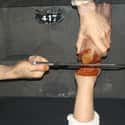-
(#1) Patients Don't See The Limb As Part Of Their Body
In 2000, Dr. Gregg Furth detailed his obsession with removing his right leg above the knee to Salon. The psychologist told writer Randy Dotinga the desire to amputate his leg dates back to around age 5. Furth says the leg is not part of him and it keeps him from being a whole person.
Other BIID victims report similar feelings that their limb is not an actual part of their being. Many even blame the offending limb for their depression or inability to create lasting relationships.
-
(#2) It Shares Characteristics With A Disorder Found In Some Stroke Victims
Researchers believe that somatoparaphrenia can occur after a stroke, affecting the right parietal lobe of the brain. The disorder manifests as a feeling of disconnection with limbs - frequently a left arm - which is very similar to BIID. Administering cold water into the patient's ear canal temporarily alleviates the symptoms.
Some studies suggest the same treatment may help those suffering from xenomelia, since the disorder might relate to the same part of the brain.
-
(#3) Only Amputation Can Cure The Patient Of Their Obsession
A 2005 group study discovered for "those who had psychotherapy or medication there was no change in the intensity of the desire for amputation." By contrast, six people in the 52-person study group proceeded with their amputations and claimed it stopped the obsessive behavior. No other appendage took the place of the removed limb, effectively "curing" the condition.
Of 21 BIID patients who removed their alien limb, all said that their lives improved without it. Most of those questioned remained content with the rest of their body parts, leading researchers to conclude amputation might be a viable treatment for the disorder.
-
(#4) Childhood Events May Play A Part In The Disorder
Many BIID subjects reported seeing a person with a disability during their early childhood. Most recalled feeling a sense of jealousy or veneration toward them because they functioned under adverse circumstances.
Interviewed patients - including Dr. Furth - claimed the feeling of an alien body part began at a relatively young. The 2005 group study revealed that 51 of the 52 participants first felt the need to remove a body part before puberty.
-
(#5) Xenomelia Can Lead To Self-Removal Or Severe Damage Of The Chosen Limb
Several studies note that patients attempted amputations through various methods - and without medical supervision. The 2014 study of 21 German BIID patients reported self-inflicted removal of limbs, with the methods used including "dry ice, a pellet-gun, self-induced infections, medicines, or a railway-coach to roll about the leg."
In an interview with Medium in 2013, "David" admitted he attempted to remove his leg by stopping blood flow to the area and said he later planned to destroy it with dry ice. "Patrick," meanwhile, conducted a test amputation of the first joint of his left index finger, cutting off its blood supply and immersing it in a makeshift numbing agent before hacking off the tip of the digit.
-
(#6) The Majority Of Sufferers Want To Remove A Leg
Dr. Michael First, author of a 2005 study of 52 BIID sufferers, told the New York Times that patients most commonly target the leg. First explained the subjects even knew the exact number of inches above or below the knee that required amputation.
The most frequent disconnect between mind and body came from the left side, whether an arm or leg.
-

(#7) Many Sufferers Choose To Travel Abroad For Amputations
Over the course of several years, Dr. Furth assisted other BIID patients in finding doctors abroad willing to perform amputations. A 2014 German study of 21 BIID patients discovered that 10 of them left the country for their appendage-removal procedure.
Of the remaining patients, eight took matters into their own hands, while one suffered an accident which removed the offending limb.
-
(#8) Legal Amputations By One Doctor Led To An Investigation
In 2000, Dr. Robert Smith of Falkirk and District Royal Infirmary in Scotland went before an ethics committee for two healthy appendage amputations he performed in 1999. After receiving permission from the medical director and chief executive of the hospital, Smith performed an amputation in April of 1999.
New hospital management denied a second patient's request, but Smith still performed the surgery. It prompted an ethics investigation, which led to a formal policy prohibiting such procedures.
-
(#9) Scientists Originally Considered It A Sexual Disorder
Although first mentioned in a letter to Penthouse magazine in 1972, scientists did not report on BIID until 1977. The first study followed the cases of two men that expressed sexual desires concerning the removal of their limbs via amputation. Based on that evidence, the study's authors called the disorder apotemnophilia - roughly translated to "amputation love" in Greek.
Later studies dismissed the sexual enjoyment factor in the disorder, with a paper published in 2013 claiming "dysfunctional central nervous system circuits" as the underlying trigger instead. The terms xenomelia and BIID emerged from those later studies.
-
(#10) The Condition Is More Prevalent In Men
Dr. First estimates thousands of people may suffer from the condition, making it relatively rare. Of that small subset of people, the majority are men. A 2005 study used phone interviews with 47 men, one intersex individual, and four women who suffer from BIID to collect data which revealed the dominance of the disorder among men.
A 2014 survey of patients, meanwhile, involved over 85% men, while a 2018 study also included more men than women.
-

(#11) A Co-Author Of The 1977 Study Suffered From BIID
Dr. Furth suffered from the disorder he first highlighted for the scientific community in 1977. A co-author on the initial BIID study, Furth went on to serve as a matchmaker of sorts for fellow sufferers of the condition - introducing a select few to doctors willing to perform amputations on healthy limbs.
Although Furth never underwent amputation himself, he spent many years sending BIID patients to Asia for surgery. Before his death from cancer in 2005, Furth handed off his duties to another BIID patient so the procedures could continue.
-
(#12) Most Patients Are Reluctant To Share Information About Their Disorder
Though Dr. Furth publicly proclaimed he suffered from BIID, most patients "are absolutely aware about the absurdity of their wish." The majority of people with BIID hide their condition from others and take great pains to keep their desires a secret.
New Random Displays Display All By Ranking
About This Tool
This is not the first time David has tried to amputate his leg. When he just graduated, he tried to cut off his leg and then took a tourniquet made of old socks and strong binding thread. Two hours later, the pain became unbearable, and fear weakened his willpower. This is a typical symptom of xenomelia that is a neuropsychiatric disease.
Patients will strongly and persistently believe that one or more of their limbs are not part of their body, they may harm their own healthy limbs, and their thoughts and behaviors are out of control. The random tool explains 12 details about how xenomelia leads healthy individuals to amputate their limbs.
Our data comes from Ranker, If you want to participate in the ranking of items displayed on this page, please click here.



















